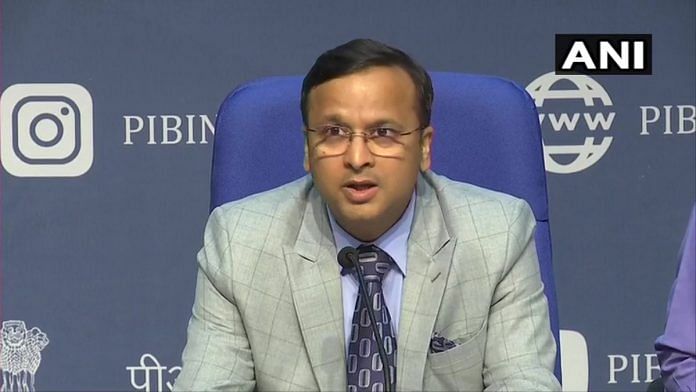New Delhi: India’s reproduction value (R) for COVID-19, which shows how fast the infection is spreading, is below one now which means that the pandemic is shrinking, the government said on Tuesday even as it cautioned that 98 per cent of the population is still vulnerable.
Addressing media, NITI Aayog member (Health) V K Paul said in many states the pandemic curve is stabilising.
“Comprehensive efforts at containment and testing are resulting in stabilisation. We still have a few states which continue to be cause of concern… there is a mixed picture but overall there is stabilisation and what we know from scientific analysis is the reproduction number is below 1 now which means the pandemic is shrinking,” Paul said.
He said this has happened because there is a huge containment effort in addition to managing the cases in home settings and hospitals.
“We are hoping and keeping the case fatality rate reasonably under control. We have to be very mindful that when we are achieving a declining positivity rate it is because of the results of what we are doing and that doing cannot be slackened. We cannot again let this go out of hand,” he said.
Lav Agarwal, the joint secretary at the Health Ministry, said 1.8 per cent of the total population in India has been affected by COVID so far which means 98 per cent of the population is still susceptible or vulnerable to the infection.
“Despite the high number of cases reported so far, we have been able to contain the spread to under 2 per cent of the population due to continued efforts by the medical fraternity, states and districts,” he said.
“This should also make us wary of protecting the still vulnerable/susceptible 98 per cent population. We cannot let our guards down, hence continued focus on containment is critical,” Agarwal said.
Giving figures from around the world, he said 10.1 per cent of the population in the US has been infected so far, 7.3 per cent in Brazil, 9 per cent in France and 7.4 per cent in Italy.
About black fungus, Paul said till now the number is not that high but it cannot be taken for granted.
“We have held discussions with all states on black fungus and there is a push on availability of Amphotericin B and till now the number is not that high but we cannot take it for granted. There are a large number of cases through which we have learnt that when a combination of diabetes, an uncontrolled one, particularly in COVID and steroid use comes up then the likelihood of this disease becomes a possibility. So whoever has diabetes should try to keep it in control,” he said.
He stressed on rational use of medication. “We reiterate that proper use of steroids has to be done and we must not take it lightly,” he said.
On COVID infection in children, Paul said it was seen that children were affected and they are asymptomatic.
“So response remains the same of what we do, we have to protect ourselves with COVID appropriate behaviour and they have to be encouraged to wear masks and main social distancing. There is a clear cut science-driven protocol already available. If COVID symptoms are seen in children then that should be followed. Severe disease in children is uncommon but we have a protocol for that too,” he said.
He said COVAXIN is also conducting a trial and it will begin in 10-12 days.
“Science’s attention is on it and children can have an asymptomatic infection and they can also spread it. We have reasonable clarity on it,” he added.
Giving statistics, Agarwal said a continuous decline in active cases has been noted in the last 15 days.
“From being 17.13 per cent on May 3, active cases now comprise 13.3 per cent of the country’s total infections. A positive trend in the recovery has also been noted. The recovery rate which was 81.7 per cent on May 3 has increased to 85.6 per cent now,” he said.
“Since May 11, daily recoveries in the country have outnumbered daily cases. India has witnessed a consistent upward trend in weekly tests since mid-February with average daily tests more than 2.5 times in the last 14 weeks. After a consistent increase in case of positivity for 13 weeks, a decline in case positivity since the last week has been reported,” he added.
“Now eight states have more than 1 lakh active COVID-19 cases, while 22 states have more than 15 per cent case positivity which is a cause for us,” he said.
Agarwal said a decreasing trend in positivity rate has been observed in 26 states and UTs.
“In Delhi, the weekly positivity has reduced from 25 per cent to 13.6 per cent. In Madhya Pradesh, Bihar, Jharkhand, Gujarat and UP also the weekly positivity has reduced. An increasing trend in weekly positivity is being noted in northeast states mainly in Meghalaya, Tripura, Mizoram, Arunachal Pradesh, Sikkim and Manipur. It is important to strengthen containment measures in these states,” he added.
Maharashtra, UP, Delhi, Bihar, MP and Chhattisgarh are among eight states showing a decline in COVID-19 cases and a decline in positivity.
Tamil Nadu, Tripura, Sikkim, Arunachal Pradesh, Manipur, Mizoram showing a rise in COVID-19 cases and a rise in positivity, he said.
He further said that eight states have more than 1 lakh active COVID-19 cases, 22 states have more than 15 per cent case positivity.
He said there are 199 districts showing a continued decline in cases and positivity since the last two weeks.
Also read: ‘Gave duty foremost priority’: PM Modi lauds state, district officials’ fight against Covid






